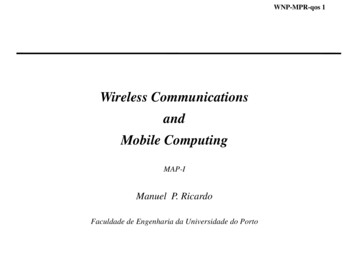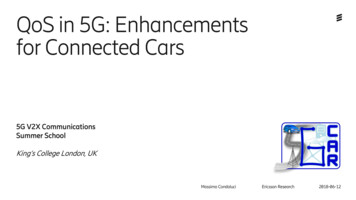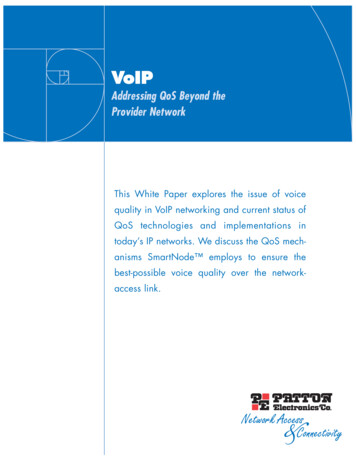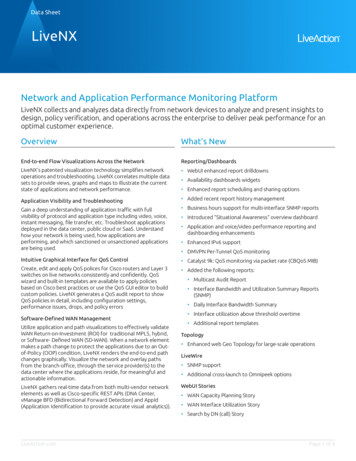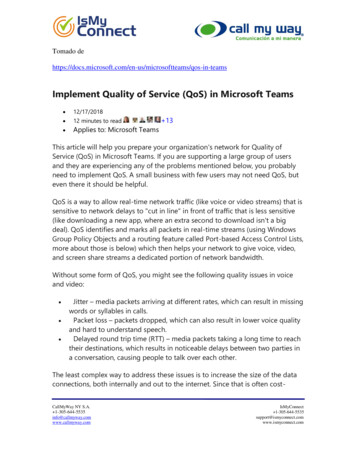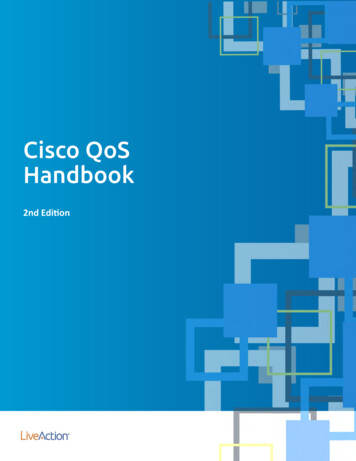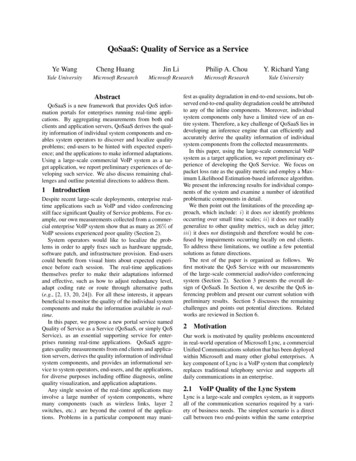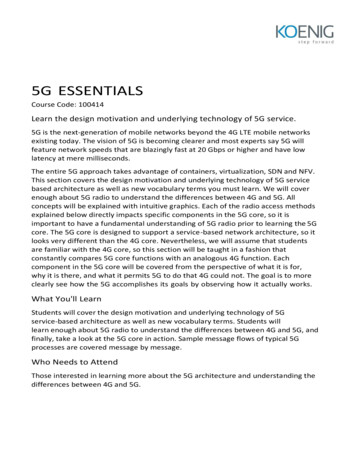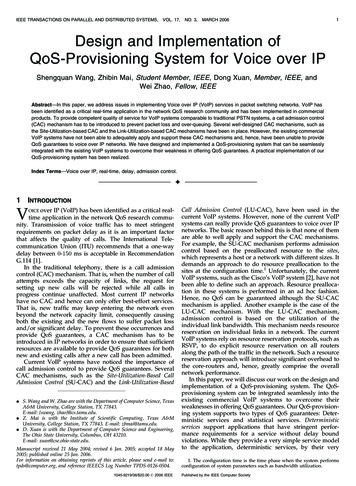
Transcription
Technical Report, IDE1070, June 2010How Different QoS Mechanisms Affect VoIPQoS MetricsMaster’s Thesis in Computer Network EngineeringMohammad Shahidul Islam & Syed Nasir MehdiSchool of Information Science, Computer and Electrical EngineeringHalmstad University
How Different QoS Mechanisms Affect VoIP QoS MetricsMaster Thesis in Computer Network EngineeringSchool of Information Science, Computer and Electrical EngineeringHalmstad UniversityBox 823, S-301 18 Halmstad, SwedenJune 2010I
PrefaceWe express our gratitude to Allah Almighty for the courage He gave us to sustain the hard work. Wecannot forget all the helpful teachers who helped us throughout our Endeavour for this lengthy period.We express our special thanks to Tony Larsson and Wagner de Morais for their support and feedback.We have thanks to offer to Ola Lundh for giving us a good start during our Master program. We thankOlga Torstensson for sharing the knowledge.We would also thank our friends for their valuable support and motivation.Finally we are thankful to our living parents and relatives who pray for us relentlessly.Last but not the least, we pray for the departed souls of our late parents and relatives who gave us theinner strength and motivation to confront the challenges of this world. The parents who gave our livesa meaning. Our tributes go their way.Peace be upon Muhammad and his progeny who are everything for us.Mohammad Shahidul Islam & Syed Nasir MehdiHalmstad University, January 2010iii
AbstractVoice over Internet Protocol (VoIP) has become a key technology of communication. Ourwork has been a practical implemenation of different scenarios to show that VoIP voicequality can be improved by adopting certain Quality of Service(QoS) measures such asclassification, marking or queuing. It has been discussed that different QoS metrics like delay,packet loss and jitter could affect the voice quality of VoIP. To reduce the negative affects,one option is to implement certain QoS mechanisms with some set of configurations. For thispurpose, Cisco IP phones have been configured in our topology with routers, switches, trafficgenerators, end stations and VoIP quality monitoring software called VQmanager. Tests havebeen divided into two sets. In one test a fixed bandwidth of 70 kbps is set while in the othertest a random bandwidth is set with trafic generators unleashing packets of traffic. In boththese tests further scenarios with configurations are worked out. They include no QoS, AutoQos and Customized Qos mechanisms. Results have been indicative of top performance bythe Customized QoS mechanism, in both sets of tests, followed by Auto QoS and no QoSmechanisms. It has been observed that a customized scenario could be a particularconfiguration to any organization’s needs and that will have the lowest delay, jitter and packetloss which are the main QoS metrics that impact the voice quality of VoIP. It can befundamentally composed of classification of voice, data or web-traffic, marking and queuingdepending upon the need of the organization. It is finally suggested to carry more tests incompanies to get more data for analysis.iv
ContentsPREFACE. IIIABSTRACT . IVLIST OF FIGURES .VII12INTRODUCTION .11.1APPLICATION AREA AND MOTIVATION .11.2PROBLEM STUDIED .21.3RELATED WORK .21.4THESIS GOALS AND EXPECTED RESULTS .3BACKGROUND .52.1VOIP SIGNALLING .52.1.1H.323.52.1.2Session Initiation Protocol (SIP).62.1.3Skinny Client Control Protocol (SCCP) .72.1.4Differences Between Peer-to-Peer and Master-Slave Control Signalling Protocols .72.2VOIP QOS METRICS .92.2.1Intrinsic Quality of Service.9Latency Delay. 9Processing or Compression Delay . 9Algorithmic Delay . 10Packetization Delay . 10Serialization Delay . 11Queuing Delay. 11Network Switching Delay. 11D-Jitter Delay . 11Jitter. 11Loss . 12Echo. 12R-Factor. 122.2.2Perceived Quality of Service .13Mean Opinion Score (MOS). 132.3VOIP QOS MODELS .14v
2.3.1Best Quality Model.142.3.2Integrated service Model.14Auto QoS. 152.3.3Differentiated service Model .16Customized QoS. 163METHODOLOGY .193.145IMPLEMENTATION .193.1.1Routing .193.1.2Mechanisms.20RESULTS .234.1FIRST SCENARIO .244.2SECOND SCENARIO .27CONCLUSIONS AND SUGGESTIONS.315.1LIMITATIONS.316REFERENCES .337APPENDIX A.348APPENDIX B.359GLOSSARY .36vi
List of FiguresFigure 1: VoIP and Object of VoIP Quality Network Topology21Figure 2: Wireshark Network Monitoring22Figure 3: Bandwidth 70Kbps23Figure 4: No QoS Scenario (Graph as illustrated by VQManager)24Figure 5: Auto-QoS Scenario (Graph as illustrated by VQManager)24Figure 6: Customized QoS Scenario. (Graph as illustrated by VQManager)25Figure 7: Graph showing the comparison of QoS mechanisms with QoS metrics25Figure 8: No QoS and TGN (Graph as illustrated by VQManager)27Figure 9: Calls with Auto QoS, TGN (Graph as illustrated by VQManager)27Figure 10: QoS factors with customized QoS and TGN (Graph as illustrated by VQManager)28Figure 11: Graph showing the trade-off and comparison of QoS mechanisms with QoS Metrics28Figure 12: End-to-End IP phone Call Flow figure34Figure 13: Different Codecs and their supportive Bandwidth [19]35vii
viii
Introduction1 IntroductionAs we move into the 4th generation cellular communications era, voice over IP (VoIP) isgaining popularity. Internet was initially designed for non real-time data transfer and it is nowevolving more and more towards other areas such as voice communications. Since internetusage has gripped the world, it could be deduced that the voice communications would evolvealong with this. VoIP is one alternative for voice communication. The Public SwitchedTelephone Network (PSTN) is another and it may well be there for only a little more time.Mobile phone communication is still new and is evolving by the day. The transformation fromcopper to fiber optics is quickly transforming new communication lines. Technologicalconvergence of Digital Subscriber Loop (DSL), broadband, cable, Worldwide Interoperabilityfor Microwave Access (WiMAX), Long Term Evolution(LTE) and telecommunications isfast approaching [2]. When we think of VoIP, the idea of a cheap call comes in mind. Thequestion that strikes one most, is that if we can achieve the same level of voice services thatwould otherwise be offered though PSTN and mobile communication then why would we notemploy VoIP everywhere?This is a big question but it is not that easy. There are a lot of other reasons ranging fromtechnical to business and political matters. Nonetheless, the growth of population andbusinesses suggest that we need all of these alternative ways of communication. There is a bigmove of convergence and integration for the important cause of saving money. Voice dataneeds more bandwidth over internet. This need can be fulfilled easily by providing morebandwidth but it is of course not for free. VoIP networks do not enjoy the prerogative ofreserved lines as PSTN enjoys. This fact can make us think twice about the omnipresence andthe availability of VoIP. VoIP gives many diverse services. Voice, fax and data can becombined over the same network. Virtual Private Networks (VPNs) for communication withina company having remote sites, online call centers, billing services in real-time andteleconferencing can be some areas of use of IP telephony [1].While there are other reasons why VoIP has not taken off on a massive scale as yet, we wantto delve deeper into the technical reasons. Technically, one problem area that the VoIP is thequality of voice. One reason for the lesser voice quality is the absence of a cutomized QoSmechanism. We shall focus on this. Currently there are some simulation studies available tostudy the VoIP QoS area but we are more interested to see the relations in a practicallaboratory experiment. The aim is to find which metrics or parameters of QoS such as delay,jitter, packet loss and bandwidth have a direct impact on voice [1]. First we need to see it on asimple scenario of two interconnected networks. The aim will be to see what kind ofmechanism serves the VoIP quality better. Can we devise a mechanism where this potentialproblem can bear some solution? Can it be a static mechanism or a rough idea of what a QoSsupporting mechanism looks like? For these questions we shall see the results.1.1Application Area and MotivationLooking at the trends in the international market of telecommunication, we see that there willbe a lot of internet usage in future. Different communication technologies are to offer variableservices in their current capacities. Current trend is towards the integration of voice, video anddata. This integration is going to happen over the IP [2]. Companies like Vonage are alreadyoffering their services in VoIP. New technologies such as WiMax and LTE promise a highbandwidth. One of the main things that VoIP needs is a good bandwidth which these newtechnologies can provide. Our interest in VoIP is because we can invest in a VoIP startupeven as an entrepreneur. In Pakistan, today it is illegal to start any VoIP services. It is dubbed1
as grey traffic in Pakistan. This situation will however not remain the same. While VoIPexpands in different markets, we can become a part of this technological revolution. There arebusiness organizations which would like to have a replacement with VoIP for many reasonslike cost reduction and other value added services that VoIP offers. Unified messaging in acorporate environment is one such application which can be offered in a VoIP package. In thisway variable communication ways could be merged to give better productivity. Email, faxand voicemail etc are all delivered to the user’s common inbox where the user can maintainhis/her communication with the whole business environment. Before choosing this topic forour thesis, we also did some market research. We are coming to a conclusion that whether theenterprise is large or small, VoIP is gaining momentum for adoption. Compared to biggercompanies the smaller ones are more likely to adopt it soon. Mostly the decisions are due tosize, finances, call quality and security [5][6]. If one embarks upon a replacement of one’scurrent communication system from PSTN to VoIP, the question arises as to which form ofVoIP, wireless or wired, should the transition take place? This is of course a strategic decisionwhere availability and cost factors should be taken into account. Main technical problemswith VoIP are call quality and security [6]. We needed to take the technical line to understandmatters related to a VoIP call quality.1.2Problem StudiedSince VoIP networks have yet to establish the credibility with regards to the quality of voice,we needed to identify the factors that can affect the voice quality most like delay, jitter andpacket loss. We studied statistics related to VoIP networks using different combinations ofVoIP QoS mechanisms. Our problem statement is to find out what the objective quality ofvoice is when we test different QoS mechanisms. For this purpose we need to do acomparison of the different QoS mechanisms like no QoS, Auto QoS and some customizedQoS parameters. Those scenarios and definitions of QoS and auto QoS have been discussed inthe coming chapters. Based upon figures we conclude that the customized QoS mechanismthat was tested along no QoS and Auto QoS mechanisms, serves VoIP QoS better.1.3Related WorkScenario 1:According to one simulation study[3], a scenario was simulated for VoIP traffic. It was basedon 3 subnets, 8 layer 3 devices, 30 layer 2 switches, 9 gateways, 6 gatekeepers. One questionasked in that simulation was ‘if the voice traffic is more than the data traffic in a certainenvironment, what effect can one expect on the voice quality?Problem 1:The end-to-end delay in this simulation study was recorded to be 300 ms. This is an obviousproblem. Acceptable delay can be upto 150 ms[4].Solution 1:Increase the number of gateways by one. By adding one gateway, the end-to-end delay wentdown 50-100% to the tune of 0-150 ms.Conversely if the data traffic is in simultaneous use along with the voice traffic, how would itaffect the system?2
IntroductionScenario 2:By increasing the number of nodes in an Ethernet network that is being used for VoIPcommunication, the delay steadily increases [4]. First, the end-to-end delay between two VoIPnodes is seen. Next when the number of VoIP nodes is increased, then the end-to-end delay isrecorded again.Problem 2:The problem is that initially when there are only two VoIP nodes, the delay figure was 1 ms.But when it is gradually increased, the delay also gets increased. For 120 VoIP nodes it is 9ms.[4] The wireless VoIP is showing more delay than the wired Ethernet delay.Solution 2:Since the delay and packet loss is increasing by increasing the number of nodes, we can thinkin terms of increasing the bandwidth per client to solve this problem.1.4Thesis Goals and Expected ResultsSome goals and expected results that we foresaw are as follows:1.Study and understand the QoS metrics in VoIP.2.Implement a network topology on the network equipment.3.Measure and test the QoS mechanisms under different scenarios with software likeVQManager.4.Evaluate and compare our results to come to a consensus point for improving voicequality through objective voice quality.5.We hope to see the customized QoS mechanism to be performing better than othermechanisms of QoS.6.Point out any ambiguities that exist and any shortcomings that we experience.7.Suggest a future line of action.3
4
Background2 BackgroundVoIP is a modern technology of communicating over internet. It requires the use of theinternet and the technology that allows data to travel between users. In the traditionaltelephone, voice travels in its analog form from your telephone to a telephone companyswitch. After that, switch will take decision for next step of your call whether call is to be sentto destination or another switch. Using the plain old telephone system (POTS) system yourphone call travels the same path along physical wires based upon where the phone call willterminate [7].This chapter reviews relevant literature on VoIP. The studies relate to VoIP networkperformance and workload such as VoIP traffic analysis and literature on VoIP QoSmeasurements.In reference [9], the paper shows implementing QoS enabled in IP network, end-to-end VoIPmechanism like VoIP in Local Area Network (LAN), VoIP in Wide area Network(WAN) andLAN–To-WAN Internetworking Qi's. This paper says that a successful VoIP implementationrequires general IP QoS protocols such as the Institute of Electrical and Electronics Engineers(IEEE) 802.1D, Resource Reservation Protocol(RSVP) and Differentiated Services(DiffServ)that provide differentiated network services based on traffic classification. However, it alsoneeds voice-specific mechanisms such as call setup signaling across multiple administrativedomains and call admission control (CAC). Here it is explained that WAN service providersoffering QoS-based IP services to enterprises need to coordinate their respective technologiesand establish some presence at their customers’ premises (e.g., via the Quality ComputerSystem (QCS)) so that QoS will be provided and managed end-to-end.According to the reference [3], this paper described the development of a simulation tool todesign and analyze communication networks. It focuses on the functions to simulate VoIP inthe various environments. Authors represent the simulator which can analyze the generalnetwork and VoIP. While the existing tools generate the voice traffic information and analyzeonly the quality of its transmission, this system is able to analyze the performance of VoIPrelated devices such as gateways and gatekeepers. Authors generated a variety of data packets,call signals and voice traffic.2.1VoIP SignallingNumerous VoIP call signalling protocols exist at the same time. The challenge is to makethem work together. One protocol works at one time. We can choose from H.323, SIP, MGCPand Megaco/H.248.2.1.1H.323The H.323 protocol is previously related to video telephony standard. When proprietaryproducts were being developed, the need was felt for developing such interoperable protocolsand services that would lessen the effect of proprietary products. In the process H.323 wasrecommended by the Voice-over-IP Activity Group of the International MultimediaTelecommunications Consortium (IMTC). H.323 was launched for multimediacommunications over packet data networks. Soon it became a standard for VoIP networks.VoIP has some backend components which are very essential for it for example VoIP gatewayrouters, VoIP gatekeepers, switches etc. H.323 gateway routers co-ordinate the functions ofdifferent networks like a public switched circuit network (PSCN) and a packet switchednetwork. The terminals of both the networks are in need of a common protocol translation and5
How Different QoS Mechanisms Affect VoIP QoS Metricsmedia transcoding. For example, a VoIP gateway converts different transmission formats intomeaningful signaling procedures between PSCN and a packet switched network. Moreover,some speech transcoding and compression functions are also the part of a gateway’sfunctions. The H.323 VoIP terminal components include some features discussed below:A System Control Unit (SCU) is to support signalling for correct operation of the H.323terminal that provides for call control using H.225.0 and H.245.H.225.0 layer changes the audio and control traffic into messages, recollects the audio streamsfrom messages that were received from the network interface, and performs logical framing,sequence numbering, error correction and detection. An audio codec transcodes and may alsocompress speech.H.323 Gatekeeper, gatekeepers have the one important function in the form of admissioncontrol and address translation. Several gatekeepers tend to associate with each other in orderto synchronize their control services. The gatekeeper is logically partitioned separately fromthe other H.323 entities, but physically it may exist along with a terminal, gateway, or anH.323 proxy. When present in a VoIP network, the gatekeeper provides these functions.1. Address translation—the gatekeepers translate alias addresses to transport addresses bymaking use of tables that get updated through messages.2. Admissions control—the gatekeeper authorizes network access using H.225 messagescheme. Admissions criteria may include call authorization, bandwidth, or other policies.3. Bandwidth control—the gatekeeper controls the bandwidth limits for a certain terminalscheme.4. Zone management—a terminal may register with only one gatekeeper at a time.Afterwards the gatekeeper could be utilized for these services by the terminals andgateways. It is optional to take part in call control signalling.2.1.2Session Initiation Protocol (SIP)SIP is a control signalling protocol. It helps in setting up or off a session. SIP finds itsdestination based on a logical name like an email address, nickname or a telephone numberrather than on an IP address. Customized messages of status notification can be a part ofdifferent SIP features. With the help of SIP we can also have text messaging features. SIPallows the concise addition of new services by third parties. Microsoft has included a SIPstack in Windows XP and new advancements are being introduced as time goes by.Since SIP can work both with intelligent devices that need little application support from thenetwork and unintelligent devices that need more support from the network, we have a similarsituation of transition from shared computers to personal computers as it happened in earlydays of computers. The applications on the mainframe computers were then accessible fromthe PCs too. While the H.323 model requires call control for application interaction, SIP userscan interact directly with applications. Traditional telephony functions and new services canwork combined in SIP. Instant messaging and video telephony being an example of latestservices.Using a client–server scheme, SIP defines logical entities that may be implemented separatelyor in a combined shape in one product. Clients send SIP requests, whereas servers accept SIPrequests, execute the request, and respond.The SIP specification defines six request methods: REGISTER helps a user or a third party toregister their contact details with the SIP server. INVITE initiates the call signalling6
Backgroundprocedure. ACK acknowledges a session while CANCEL does the reverse. BYE terminates asession. OPTIONS contains different available options on the server.2.1.3Skinny Client Control Protocol (SCCP)Skinny Client Control Protocol (SCCP) is primarily used with IP phones. SCCP is utilized forthe communication of call manager and end devices, such as VoIP phones. SCCP is alsosupported by different vendors. It’s a kind of client server protocol. For example, every eventlike any calling function, on-hook or off-hook causes signals to be transmitted to callmanager. A call manager will instruct the device for next task like what to do when thiscondition occurs. When the end user presses any button for data sending to destination, at firstboth make the communication between end user and call manager. The end station of a LANor IP- based Private Branch Exchange (PBX) should be easy to use, intimate and relativelyinexpensive. The skinny client like Ethernet Phone uses transmission Control Protocol TCP/IPto send and receive calls and Real-Time Transport Protocol(RTP)/UserDatagramProtocol(UDP)/IP to send or receive data from Skinny Client. Skinny messages use port 2000and carry the message above TCP [1]. There are some benefits of SCCP for example, itsupports rapid change in the protocol. It is the easiest protocol for IP-Telephony network. IfSCCP is used in the IP-Telephony, it can work with H.323 together [1]. SCCP can also makedifferent required functions in the network. The skinny client can communicate using anH.323 proxy.2.1.4Differences Between Peer-to-Peer and Master-Slave Control Signalling ProtocolsH.323 and SIP are peer-to-peer control-signalling protocols. MGCP and Megaco are relativelynew and are master–slave control-signalling protocols. MGCP is based on the PSTN model oftelephony. H.323 and Megaco are intended to have capacity for video conferencing as well asbasic telephony. Call control utilities are more in number in H.323 than MGCP. MGCPstipulates most of the intelligence to be centred in a segregated media gateway controller. SIPis made indigenously to support a range of applications apart from the voice [14].7
How Different QoS Mechanisms Affect VoIP QoS MetricsPeer-to-Peer Control Signalling ProtocolsMaster-Slave Control Signalling ProtocolsH323SIPMGCPMegacoDesigned toaccommodate videoconferencingalongside basictelephonyBasically meant forIP networks whichalso supports PSTNfunctionalities.Based on PSTNmodel of basictelephony.Designed toaccommodate videoconferencingalongside basictelephonyH.323 gateways havemore call controlfunctions than mediagateway.SIP users can directlyinteract with differentapplications on thenetwork while H.323requires the callconrol functions.MGCP centers moreintelligence in aseparate mediagateway controller.H.323 does the job ofaddress translationand in that IPaddresses are alsoincluded.SIP does not makeuse of IP addressesfor identification of alogical destination.MGCP supports theauthentication ofsource address.Megaco also supportsthe authentication ofsource address.TCP/UDP aresup
Voice over Internet Protocol (VoIP) has become a key technology of communication. Our . This integration is going to happen over the IP [2]. Companies like Vonage are already offering their services in VoIP. New technologies such as WiMax and LTE promise a high bandwidth. One of the main things that VoIP needs is a good bandwidth which these new
